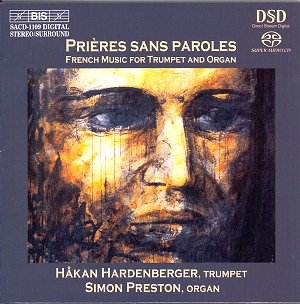Where this programme succeeds most creditably, is in
its exploration of the range of the trumpet as a solo instrument. Although
very different in character, Naji Hakimís Sonata and Henri
Tomasiís Semaine Sainte à Cuzco are the most effective
works in demonstrating the sheer brilliance of sound of the instrument
(and what a sound Hardenberger possesses!). Tomasiís piece takes as
its inspiration the Peruvian archiepiscopal seat established by the
Spanish, and pits a wonderfully glittering high fanfare-like trumpet
line against a swaying organ accompaniment with a restrained, contrasting
central section before the opening fanfare material returns. It is a
brilliant, imaginative piece of writing and Hardenbergerís playing lives
up to it in every respect. In complete contrast Hakimís Sonata is a
glitzy, jazz inspired affair, complete with references to Gershwinís
American in Paris in the first movement. Once again, the writing
for the trumpet is distinguished, as is the organ part (to be expected
from Messiaenís successor at the Église de la Trinité
in Paris). The sense of fun at times disguises the virtuosity of the
writing, yet Hardenberger responds with effortless playing.
André Jolivet gives us the most austere
work on the disc, although his deceptively titled Arioso barocco,
is both rewarding and imaginative. Based on a baroque model of aria
and recitative, the predominantly contemplative nature of the music
is eventually disturbed by a high, soaring trumpet line that rings magnificently
around Aarhus Cathedral before settling to a subdued conclusion. Again,
in complete contrast the work that gives the disc its title by Jean-Michel
Damase (Three Prayers Without Words) is an altogether lighter conception,
unmistakably French in its relaxed lyricism and perhaps closest to Poulenc
in melodic and harmonic language. Hardenbergerís seamless legato style
is a delight, the music charming and undemanding.
La Statue retrouvée by Satie is
notable for its brevity (1í22") and even more so for the brevity
of the trumpet part, which makes its first entry at around 1í05"!
In reality however this little march, revolving around a rediscovered
statue, is amusingly entertaining in a typically Satiesque way.
The remaining three works are less memorable and certainly
in the case of Pierre Jansen's Processional I found my
attention wondering (as does the music) after around two minutes although
the bold climactic central section does hold more interest. I felt rather
similar about Alleluias, the work that opens the disc by Roumanian
born Marius Constant. The booklet notes tell us that Constant
is "now one of the principal protagonists of contemporary music
in France" yet on the evidence here I found the musical ideas in
this ten minute piece somewhat lacking in definition. Henri Sauguetís
Non morietur in æternum is more effective in this respect,
managing impressive contrast within a relatively brief five-minute duration.
Audiophiles will find this super audio disc will play
on both conventional CD players and SACD machines giving multi channel
sound for those who have the capability. On my conventional player I
found the sound of the trumpet to be first class although the organ
would have benefited from being a little closer in the overall balance.
Nevertheless, this is a relatively minor quibble given the outstanding
performances of Hardenberger and Preston. I cannot imagine any of these
works being played with greater commitment or panache.
